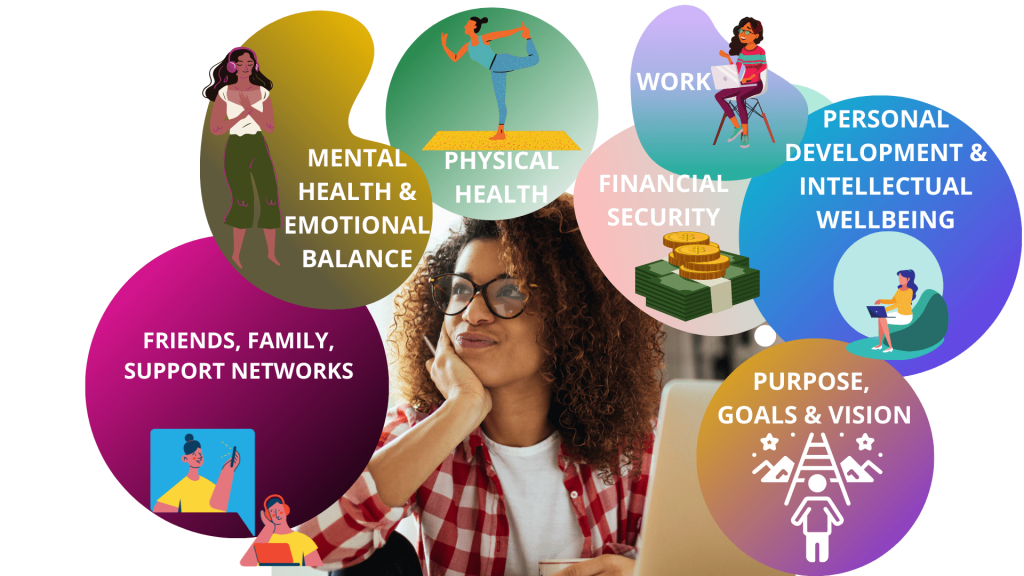Pillars Of Employee Wellbeing
It takes a myriad of elements to achieve complete wellbeing. As technology develops and uncertainty increases, a healthy dose of resilience is required to remain adaptable.
These dimensions of wellbeing are of growing importance in keeping employees well.
We share ways to embed these elements into your strategy for robust and meaningful wellbeing programs.

Social & Emotional Wellbeing

Social wellbeing can be defined as the quality of interactions and relationships one has with their colleagues, managers…etc
WORKBLIS social wellness sessions focus on bringing employees together to engage in an activity outside the realm of work. This breathing space can develop interpersonal skills and improve creativity, morale, engagement, performance, stress relief, employee relations, workplace culture, employer brand, retention and employee attendance.
TIP: Provide outlets for stress relief and embed within them within emotional and mental health strategies. WORKBLIS delivers a range of social sessions – virtually and onsite. This is delivered to your schedule as lunchtime sessions, mid-afternoon energy boosters, monthly wellness perks, elements within a team-offsite, and breakout sessions within conferences and onboarding programs.
Mental Wellbeing

Employers recognize that mentally fit employees are an asset to their organization. They are more engaged, thus deliver higher performance and cost less to maintain.The key is not only to keep employees healthy, but to equip them with the tools to be able to effectively deal with challenges if they arise.
Managers are relied heavily upon to spot the signs of mental ill health, and be a tower of strength for their direct reports. Providing management with the skills to do this constructively is essential to the success of a wellbeing program.
Take into account that the manager also needs to nurture their own wellbeing in order to be more empathetic to the wellness needs of others.
TIP: Identify the key mental health challenges affecting your organization. Deliver training and support that directly mitigate these risks. Your managers need support. Provide them with self care tools to nurture their personal wellness needs. The benefits filter down to direct reports.
WORKBLIS delivers a comprehensive range of tutorials to support metal health strategies.
Physical Wellbeing

The evolution of work and increased convenience due to the prevalence of sophisticated technologies means that more people are living sedentary lives. Technology has also fuelled an ‘always-on’ culture, and there is a surge in growth of dependency on takeouts – especially amongst young single adults.
TIP: Create a physical wellness program that raises awareness of the risks and share practices for improved lifestyles. A holistic program includes Physical Wellbeing Presentations, Nutrition Workshops, and Fitness Sessions.
If cardiovascular health is a major risk factor, deliver practical nutrition sessions and daily/weekly live fitness classes. The camaraderie of improving health with colleagues brings fun into the wellness journey.
If injury prevention and employee safety are of concern, deliver sessions that improve reaction time motor skills and enhance cognitive performance.
If fatigue and lack of focus is an issue, deliver live fitness sessions at times you notice a dip in productivity.
Financial Wellbeing

Financial health is viewed as a factor that can improve or impede mental health. Strong financial literacy can help minimize the stress and anxiety associated with not having the lack of funds when needed. Creating an emergency budget, tracking spending, increasing purchasing power and managing the family budget are some of the tutorials available to help improve financial wellbeing.
Employers deliver these sessions because they know that money worries represent a large chunk of the anxiety pie chart. Minimizing this concern allows employees to focus better on work, thus increasing performance.
TIP: Several countries have a Financial Literacy Week. Deliver a range of tutorials to increase awareness of personal finance management.
Intellectual Wellbeing

Continuous learning keeps employees growing and improving. From specific hard skills to soft skills required to function better as an individual, learning can be used as a tool to keep performance, engagement and motivation levels high.
This section comprises the purpose, goals, vision, and work dimensions of employee wellbeing.
WORKBLIS delivers a range of stimulating skills tutorials useful for self growth and personal effectiveness.
These are segmented into Learning & Development; Leadership & Management Skills; and Remote Wellness Training.
TIP: Monthly skills training can create a culture of learning within your organization – helping to engage and empower employees.

